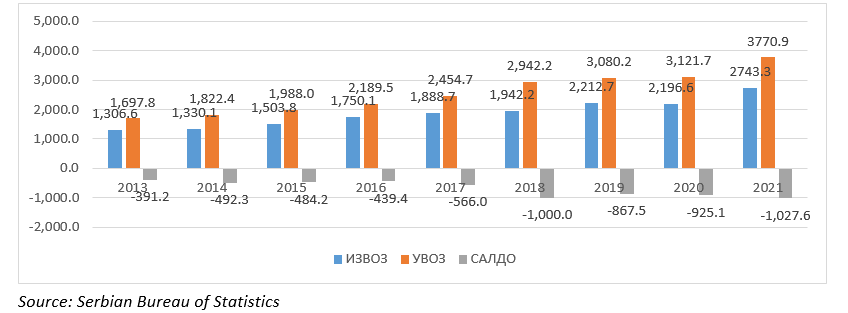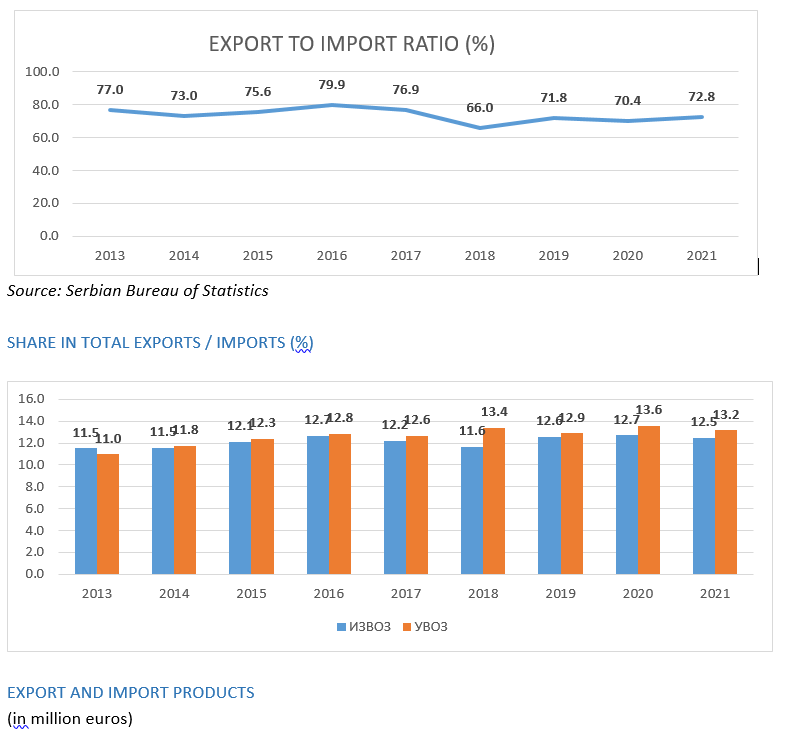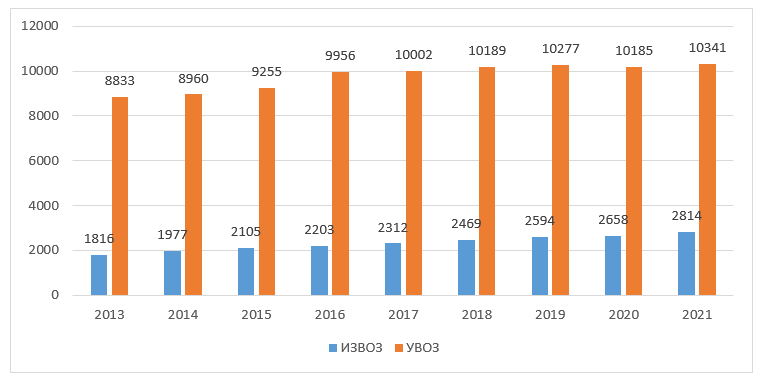Based on the data collated by the Ministry of Finance of the Republic of Serbia – Customs Administration, in 2021, a total of 11,539 companies in Serbia did business with the Federal Republic of Germany.
According to the data collated by the State Statistical Office, the total trade between the Republic of Serbia and the Federal Republic of Germany in 2021 amounted to 6.5 billion euros. Serbia’s export to Germany amounted to 2.7 billion euros, while the import totalled 3.8 billion euros. The export-to-import ratio stood at 72.8%. The Federal Republic of Germany is the leading external trade partner of the Republic of Serbia in 2021, both in terms of the total exports (a 12.5% share) and the total imports (a 13.2% share).
The total trade in services between the Republic of Serbia and the Federal Republic of Germany in 2020 amounted to 1.07 billion euros, of which the Republic of Serbia earned 677 million euros, and had expenditures in the amount of 397 million euros. From January to November 2021, the total trade in services between the Republic of Serbia and the Federal Republic of Germany amounted to one million 1.17 billion euros, of which the revenues of the Republic of Serbia amounted to 746 million euros and expenditures 429 million euros. The Federal Republic of Germany is the second biggest partner of the Republic of Serbia in terms of trading in services.
According to the methodology used by the National Bank of Serbia, the total net investments of residents of the Federal Republic of Germany in the Republic of Serbia in the period from 2010 to September 2021. amounted to 2.134 billion euros.
FOREIGN TRADE TRADE BETWEEN THE REPUBLIC OF SERBIA AND THE FEDERAL REPUBLIC OF GERMANY IN THE 2013 – 2021 PERIOD (IN MILLIONS OF EUROS)


The two countries mostly exported these products – ignition wiring kits, as well as other kits for vehicles worth 419.9 million euros (a 15% share), as well as automotive train cars worth 50 million euros (a 2% share).
The two countries mostly imported these products from each other – unclassified goods in the customs tariff (goods in storage) worth 332.2 million euros (a 9% share), while in tenth place are specialized machines and devices worth 30.6 million euros (a share of 1%).
NUMBER OF EXPORTERS / IMPORTERS 2013 – 2021

COMPANIES
Based on the data collated by the Ministry of Finance of the Republic of Serbia – Customs Administration, in 2021, a total of 11,539 companies in Serbia did business with the Federal Republic of Germany.
- Number companies that only export to the Federal Republic of Germany – 1,199
- Number companies that only import from the Federal Republic of Germany – 8,725
- Number companies that both export and import – 1,615
COMPANIES WITH MAJORITY GERMAN CAPITAL IN THE REPUBLIC OF SERBIA
According to the data of the Business Registers Agency of the Republic of Serbia, there are 807 active companies in the Republic of Serbia, which are majority-owned by the citizens of the Federal Republic of Germany, i.e. companies registered in the Federal Republic of Germany (data from January 28, 2022).
The largest number of companies operate in the following economic sectors:
| 1 | G – Wholesale and retail and repair of motor vehicles | 156 |
| 2 | C – Manufacturing industry | 150 |
| 3 | N – Administrative and related services | 132 |
| 4 | M – Specialized, scientific, innovative and technical services | 123 |
| 5 | J – Information and communication | 90 |
| 6 | F – Construction | 59 |
| 7 | X – Transport and storage | 20 |
| 8 | A – Agriculture, forestry and fishing | 14 |
| 9 | I – Accommodation and catering services | 11 |
| 10 | L – Real estate activities | 11 |
POTENTIAL FOR BETTER COOPERATION
The Federal Republic of Germany is one of the most important external trade partners of the Republic of Serbia. However, in trading with Germany, the Republic of Serbia usually generates a deficit. The largest deficit generator is the SITC sector 7 – Manufactured products – where the largest deficit is generated by passenger and freight vehicles and parts industry. The same applies to the SITC sector 5 – Chemical products – with the main deficit generators being medication and blood fractions.
The two countries could cooperate more in the following industrial sectors: the agri-food sector (fresh, frozen and canned fruits and vegetables, organic food, fine food and specialties, wine, canned meat, spices, soups, dried vegetables, mushrooms), metal processing industry (auto parts), wood industry (solid wood and rustic furniture, furniture parts, prefabricated houses). textile industry (clothing, leather and footwear), construction (building material industry, through detachment contracts with Bavarian partners for the execution of construction works) and the IT industry (software & hardware).
PROMISING COOPERATION SECTORS
In the Furniture group of products, the Republic of Serbia and Germany boost their cooperation in the subcategories such as ‘other furniture and furniture parts’, which Germany imported in 2019 in the amount of 1.87 billion and the subcategory ‘seats and their parts’ (excluding those from the customs tariff number 9402) which Germany imported in the amount of 199 million euros.
In regard to the Plastics and Plastic Products group, the two countries could trade more in the following subcategories – flooring and wallpaper, plastic utensils and other plastic products for home of plastics. In 2019, the two countries imported these products in the value of 600.1 and 394.6 million euros, respectively.
When it comes to the Edible fruits and nuts group, Germany has been increasingly importing fresh and dried fruits and mixed nuts from Serbia.
Products that could boost the economic cooperation between Serbia and Germany include corn, sunflower oil and other vegetable fats. There is also potential for the export of canned vegetables, frozen vegetables and canned mushrooms. Furthermore, industrial plants, flour and seed also have a great export potential for Serbia, as do non-electric household appliances and various types of brandy of which Germany imported around 283 million euros worth in 2019.
INVESTMENTS
Beginning in 2014, in accordance with IMF guidelines and the EU accession efforts, the National Bank of Serbia changed the methodology used in calculating foreign direct investments (as outlined in the “IMF’s Manual on Balance of Payments and International Investment Position No. 6”). In line with the new methodology, net foreign direct investments data is calculated as the difference between the net increase in financial assets (net output investments, i.e. inflows and outflows based on residents’ investments abroad) and the net increase in financial liabilities (net incoming investments, i.e. inflows and outflows based on non-residents’ investments in Serbia) and include investments in money, goods, debt-to-equity conversion, intercompany loans and reinvested earnings.
According to this methodology, the total net investments made by residents of the Federal Republic of Germany in the Republic of Serbia in the period from 2010 to September 2021 amounted to 2.137 billion euros. The Federal Republic of Germany occupies the 5th place on the list of the largest investors in Serbia in 2020.
| Foreign direct investment
(liabilities based on investments of non-residents in Serbia) – in millions of euros – |
|||||||||||||
| 2010. | 2011. | 2012. | 2013. | 2014. | 2015. | 2016. | 2017. | 2018. | 2019. | 2020 | I-IX 2021 | TOTAL | |
| 103,5 | 198,7 | 93,1 | 83,5 | 36,5 | 72,4 | 179,6 | 185,4 | 263,3 | 335,8 | 353,4 | 232,7 | 2.137,9 | |
Source: NBS